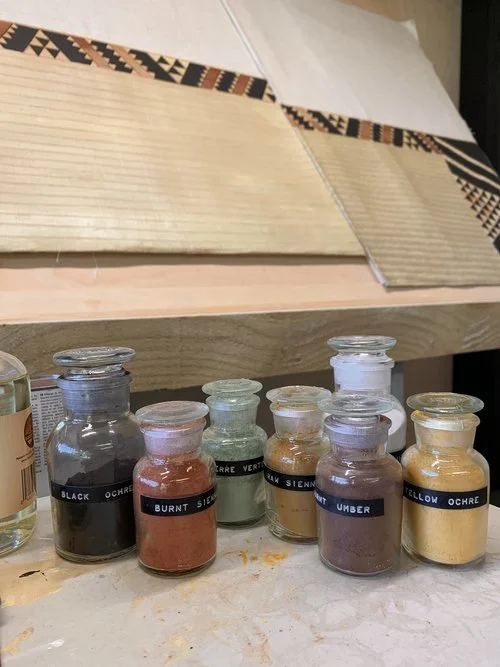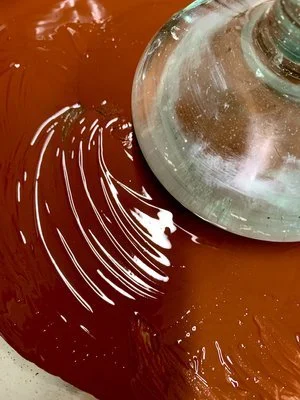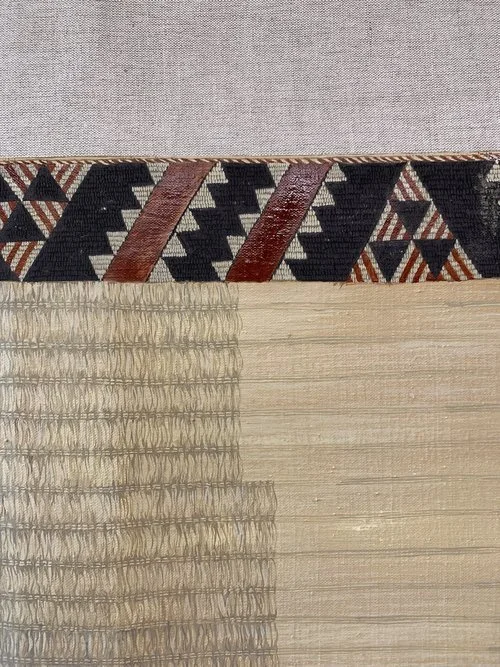Ka kite au I a koe
But Even at This Distance I Recognise You
Commissioned for the lobby of the Bell Gully Building
Marita working on the artwork in her studio.
About the artwork, from the artist Marita Hewitt
To produce this artwork that acknowledges the mana whenua of the site, I first delved into research to find a meaningful and accurate way to interpret the connection between the hidden awa below, the whenua, the people, and time, in what is now known as Wellington Harbour.
It was important to me that the work communicates in a language that resonates with the past, the present, and the future, addressing with respect the many difficulties that lie within the history of Aotearoa.
The Kūmutoto Stream, which flows underneath the Bell Gully Building, was one of many waterways which once ran from the surrounding hills into the bay. This was a central harakeke (flax) collection point for the neighbouring Pā sites of Pipitea and Kūmutoto.
The importance of Harakeke
Harakeke was traditionally used by early Māori for a range of purposes, including the making of clothing and was regarded as a staple resource of great importance. The structure of the harakeke plant posits the newest tamariki (shoots) at its centre, with the generations of older whanau (leaves) protecting each other as the plant grows. This structure and its meaning from a Māori worldview reverberates with me as a parent, as well as embodying the material in all its transformations with a particular mauri (life force).
I had recently produced a body of work inquiring into the traces of my own ancestry through the memories clinging to garments once worn. I wanted to follow this thread for the artwork by finding a garment belonging to someone who once lived close to the site, preferably one made of the harakeke gathered from the Kūmutoto Stream.
Drawing inspiration from Ruhia Pōrutu’s story
Unfortunately the documentation of early Māori garments with accurate iwi or locational provenance is extremely limited. However with the help of a few people I encountered Ruhia Pōrutu's story in a Te Papa collection book Whatu Kākahu; and was captivated. The power behind her bold action, using the kākahu (cloak) off her own back in a sweep of dynamic opposition to defend two young English boys, demonstrated a heroic strength of intent. This spoke of an inherent humanity; a maternal instinct of protection and a respect for difference. A notion as significant and necessary in Aotearoa today as it was then.
My artwork aspires to celebrate Ruhia's story of mana whenua, encouraging a dialogue with and between viewers. My intent was to ascribe a piece of her emotive power through a floating representation of a section of her kākahu, laid out horizontally, as she once did, akin and belonging to the Kūmutoto Stream below.
Pigments
Earthen pigments were ground up with walnut oil and applied to a prepared flax linen surface in multiple layers, with careful attention paid to truthfully render the resplendent craftsmanship of this taonga (artifact).
To find out more about Marita visit maritahewitt.com
Marita with the artwork in situ in the lobby of the Bell Gully Building.







